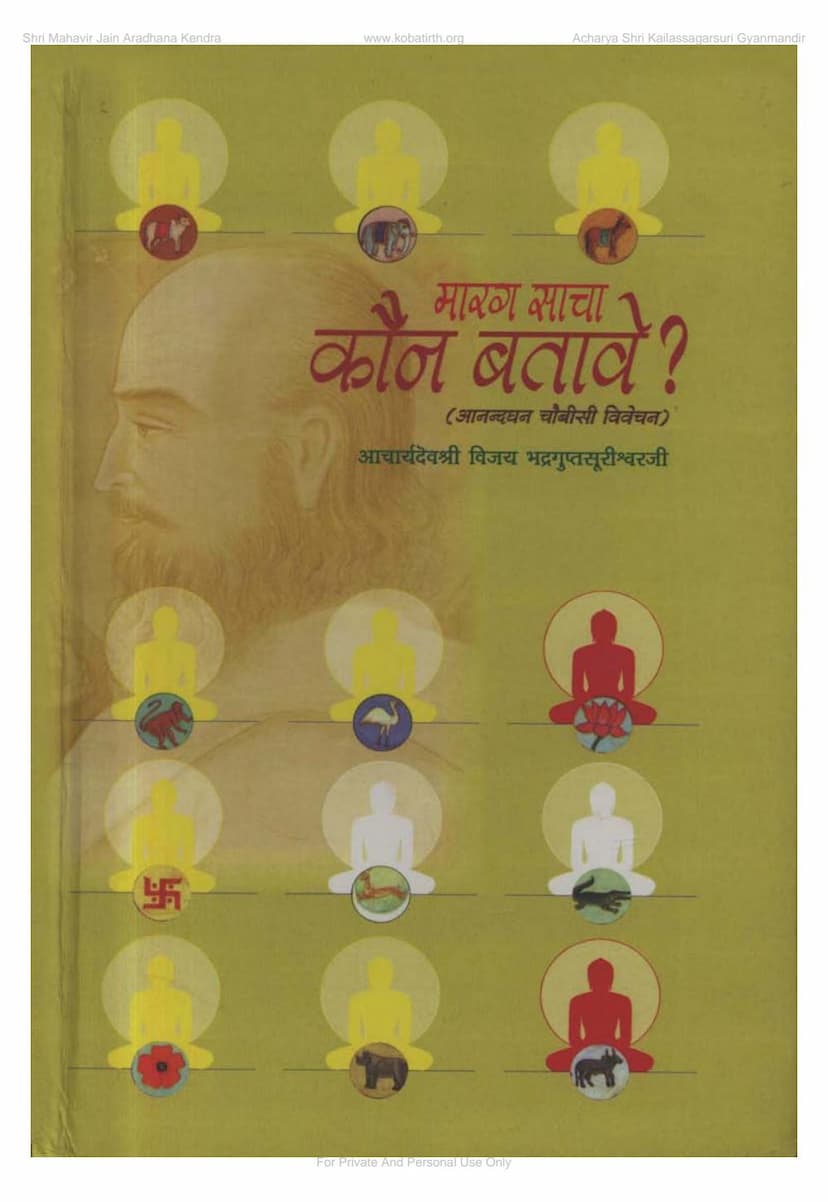Magar Sacha Kaun Batave
Added to library: September 2, 2025

Summary
Here's a comprehensive summary of the Jain text "Magar Sacha Kaun Batave" by Bhadraguptasuri, based on the provided pages:
Book Title: Magar Sacha Kaun Batave (मारग साचा कौन बतावे?) Author of the Original Work: Shri Anandhanji (श्री आनन्दघनजी) Commentator/Author of this Explanation: Acharya Shri Vijay Bhadraguptasuri Ji Maharaj (आचार्य श्री विजयभद्रगुप्तसूरिजी महाराज) [Shri Priyadarshan] (श्री प्रियदर्शन) Publisher: Shri Mahavir Jain Aradhana Kendra, Koba (श्री महावीर जैन आराधना केन्द्र, कोबा)
Overall Purpose: This book is a commentary and detailed explanation of the "Anandhan Chovis" (आनन्दघन चौबीसी), a collection of 24 hymns dedicated to the 24 Tirthankaras composed by the renowned 18th-century Jain ascetic, poet, and mystic, Shri Anandhanji. The commentary aims to make the profound spiritual and philosophical teachings within Anandhanji's hymns accessible and understandable to a wider audience through simple, yet insightful explanations.
Key Themes and Content:
-
The Quest for the True Path (मार्ग साचा कौन बतावे?): The title itself encapsulates a central theme – the difficulty of finding the true spiritual path. Anandhanji, through his verses and Bhadraguptasuri through his commentary, explore how various philosophical and religious systems offer different perspectives, often leading to confusion. The book emphasizes that only the path illuminated by the omniscient (Sarvajna) can truly guide one.
-
Commentary on Anandhanji's 24 Hymns: The core of the book is the systematic explanation of each of Anandhanji's 24 hymns, dedicated to each Tirthankara. Each letter (पत्र) or section is dedicated to a specific Tirthankara.
-
Focus on Divine Love and Devotion (परमात्म-प्रीति और परमात्म-भक्ति): A recurring and central theme across the commentaries is the importance of sincere, selfless love and devotion towards the Supreme Being (Paramatma). Anandhanji's hymns are presented as expressions of this deep love, and Bhadraguptasuri elaborates on how this love leads to liberation. The distinction between true, unconditional love and conditional, selfish affection is highlighted.
-
Spiritual Journey and Self-Realization: The letters, often addressed to a spiritual seeker named "Chetan" (चेतन), guide the reader through various stages of the spiritual journey. They discuss:
- Understanding the Divine: The nature of the Tirthankaras and the Supreme Being as omniscient, compassionate, and the ultimate refuge.
- The Role of the Mind: The challenges posed by the restless mind and the methods to control and purify it through devotion, study, and contemplation.
- Scriptural Study (Agam Study): The importance of deeply studying Jain scriptures (Agamas) with a pure and calm mind to gain true knowledge and strengthen faith.
- The Path to Liberation: The ultimate goal is the attainment of the pure, liberated soul (Paramatma), achieved through selfless devotion, adherence to Jain principles, and the grace of the Tirthankaras.
-
Philosophical Insights and Nuances:
- Nayas (Anekantavada): The commentary delves into the Jain philosophical concept of "Nayas" (viewpoints or perspectives) and "Anekantavada" (non-absolutism). It explains how understanding different Nayas is crucial for comprehending complex truths without falling into rigid, one-sided viewpoints.
- Karma Theory: The nature of karma, its bonding, fruition (Uday), and eventual shedding (Nirjara) are discussed in relation to the spiritual path.
- Distinguishing True vs. False Spiritual Paths: The text critically examines various philosophical schools and practices, differentiating between those that lead to true liberation and those that create further attachment or delusion. It warns against superficial rituals and mere intellectual understanding without inner transformation.
- The Importance of a Pure Mind: Repeatedly, the commentator emphasizes that external actions are less significant than the inner state of the mind. A pure, calm, and detached mind is essential for spiritual progress.
-
The Author's Background (Acharya Shri Vijay Bhadraguptasuri Ji): Page 4 provides a biographical sketch of Acharya Shri Vijay Bhadraguptasuri Ji, highlighting his extensive study of Jain Agamas, his prolific writing career, his compassionate nature, and his dedication to the welfare of the community, especially the youth. His passing in 1999 is also mentioned.
-
The Publisher's Endeavor: Pages 5 and 6 explain the context of this republication by the Shri Mahavir Jain Aradhana Kendra, Koba. They express their desire to preserve and disseminate the valuable spiritual literature of Acharya Bhadraguptasuri, following the dissolution of the original publishing trust. The generous support of the Sheth Shri Narottamdbhai Lalbhai family is acknowledged.
-
Structure: The book is structured as a series of letters (पत्र) from the commentator (Priyadarshan) to a disciple named Chetan. Each letter, or set of letters, focuses on the interpretation of a specific Tirthankara's hymn from Anandhanji's Chovis. The book also includes a table of contents (अनुक्रम) listing the hymns and details about each Tirthankara.
Key Takeaways for the Reader:
- The true path is found through introspection and adherence to the teachings of the omniscient Tirthankaras.
- Unconditional love and devotion towards the divine are paramount.
- The mind is a powerful tool and a significant obstacle; its purification is key to spiritual growth.
- Scriptural study, contemplation, and sincere practice are essential for understanding and internalizing spiritual truths.
- The commentary provides practical guidance on how to approach worship, spiritual texts, and the overall spiritual journey.
- The book encourages readers to engage deeply with the teachings, not just intellectually but also emotionally and experientially.
In essence, "Magar Sacha Kaun Batave" is a devotional and philosophical guide that illuminates the spiritual path through the lens of Shri Anandhanji's profound hymns, explained with clarity and compassion by Acharya Shri Vijay Bhadraguptasuri. It serves as a bridge between ancient wisdom and the contemporary seeker.